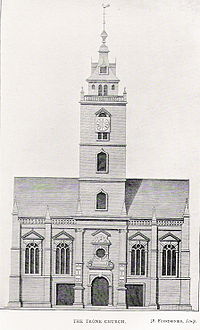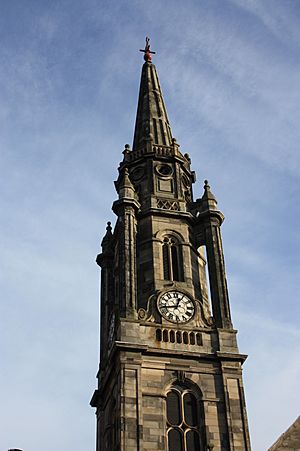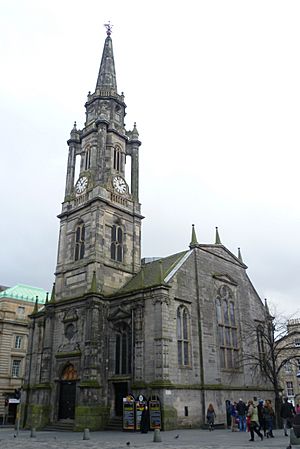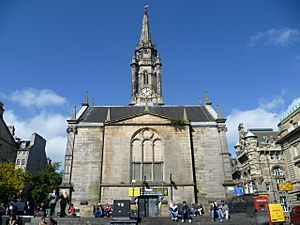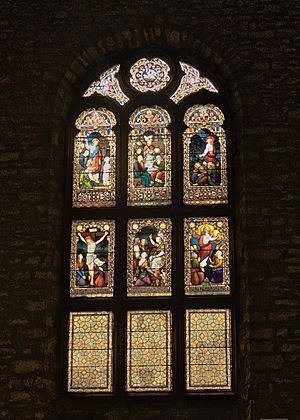Tron Kirk facts for kids
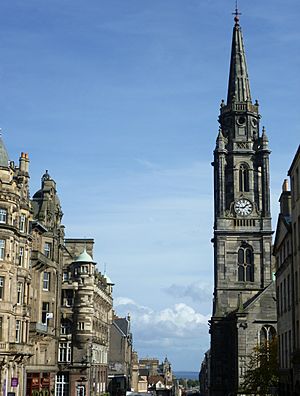
The Tron Kirk is a famous old church building in Edinburgh, Scotland. It's a well-known landmark right on the Royal Mile, a historic street in the city. Built in the 1600s, it stopped being used as a church in 1952. For many years, it was empty, but then it became a place for tourists to get information. More recently, it has hosted an exhibition about Edinburgh's history and a book and gift shop.
The name "Tron" comes from a special weighing scale (called a tron in Scots) that used to stand outside the church. This scale was used for the public market on the Royal Mile until about 1800.
The Tron Kirk is special because it's the only church in Scotland where five ministers in a row each served as the Moderator of the General Assembly of the Church of Scotland. This "Moderator" is like the head of the Church of Scotland for a year.
Contents
- Discovering Old Edinburgh: What Was Here Before?
- A Place of Worship: The Church's Story
- Who Led the Church? Ministers of the Tron
- Important Moments at the Tron Kirk
- How the Church Was Built: Its Architectural Journey
- Celebrating New Year: Hogmanay at the Tron
- Arts and Culture: The Tron at the Edinburgh Festival Fringe
- Learning About History: Edinburgh World Heritage at the Tron
- Future Plans: Scottish Historic Buildings Trust
Discovering Old Edinburgh: What Was Here Before?
Before the Tron Kirk was built in the 1630s, people explored the area using special tools and digging. They found out that the land was covered with tall buildings called tenements in the 1400s and 1500s. These buildings covered up any signs of even older medieval villages.
The church was built over three old narrow streets or alleys:
- Marlin’s Wynd
- Peebles Wynd
- Taverner's Close
In 1974, the church floor was taken up so archaeologists could dig everywhere. For a while, visitors could see the old basements, paved alleys, and water channels from a walkway. It was like looking back in time, similar to the ancient city of Pompeii.
A Place of Worship: The Church's Story
The first stone of the Tron Kirk was laid on March 4, 1637. The church officially opened in 1641 and was dedicated to Christ. It was known as "Christ's Kirk at the Tron." It was built for one of Edinburgh's four church areas after the Scottish Reformation in 1560.
Important people like nobles, judges, and university professors had special seats in the church. We even have lists of who sat where from 1650 and 1745!
Who Led the Church? Ministers of the Tron
Many important ministers served at the Tron Kirk over the centuries. Here are some of them:
- 1641 to 1649 - William Colvill
- 1648 to 1662 - Robert Laurie
- 1663 to 1672 - John Paterson
- 1672 to 1675 - William Annan
- 1675 to 1680 - James Lundie
- 1681 - Robert Bruce
- 1683 to 1687 - George Trotter
- 1687 to 1691 - Alexander Malcolm
- 1687 to 1692 - William Erskine
- 1695 to 1707 - William Crichton
- 1707 to 1729 - William Wishart
- 1730 to 1785 - George Wishart, who served the longest
- 1786 to 1809 - Andrew Hunter of Barjarg
- 1809 to 1845 - Alexander Brunton
- 1845 to 1867 - Maxwell Nicholson
- 1868 to 1873 - James MacGregor
- 1874 to 1875 - John Barclay
- 1876 to 1881 - William Cruickshank Eddie Jamieson
- 1881 to 1885 - John Methven Robertson
- 1885 to 1911 - David Morrison
- 1902 to 1907 - Dugald Butler
- 1908 to ? - John Wallace
Second Ministers
The Tron Kirk was so big that it needed a "second charge" minister to help with services.
- 1650 to 1655 - John Stirling
- 1663 to 1665 - James Lundie
- 1665 to 1676 - Robert Mortimer
- 1677 to 1682 - John Farquhar
- 1682 to 1683 - George Trotter
- 1683 to 1689 - John Strachan
- 1691 to 1709 - George Meldrum
- 1710 to 1713 - John Steedman
- 1715 to 1741 - Matthew Wood
- 1745 to 1753 - William Wishart
- 1754 to 1766 - John Jardine
- 1767 to 1788 - John Drysdale
- 1789 to 1831 - William Simpson
- 1832 to 1860 - John Hunter
The role of the second minister at Tron ended in 1860.
Important Moments at the Tron Kirk
Many important events happened at the Tron Kirk.
- In 1697, a young student named Thomas Aikenhead was accused of saying things against God outside the Tron Kirk. This was a very serious accusation at the time. He became the last person in Scotland to face such a punishment for this type of crime.
- Many famous people from Edinburgh were baptized or married at the Tron. For example, the well-known judge John Lauder, Lord Fountainhall was married here in 1669.
- Reverend John Drysdale, a minister at the Tron from 1766 to 1788, was a good friend of the famous economist Adam Smith.
- The main meeting of the General Assembly of the Church of Scotland was held at the Tron from 1830 to 1840.
How the Church Was Built: Its Architectural Journey
King Charles I ordered the Tron Kirk to be built. It was designed by John Mylne, a royal master builder, and constructed between 1636 and 1647. The design mixed different styles, including Palladian and Gothic elements, and was inspired by Dutch buildings.
In 1785, parts of the church were removed to make way for the South Bridge and Blair Street. The original spire was destroyed in a big fire in November 1824. A new spire, designed by R & R Dickson, was built in 1828.
The Tron Kirk stopped being a church in 1952. The building was then bought by the City of Edinburgh Council.
Celebrating New Year: Hogmanay at the Tron
For a long time, the Tron Kirk was the main place where people gathered to celebrate New Year's Eve, known as Hogmanay in Scotland. Its clock tower was high and could be seen and heard from far away.
Even though the city now has a big organized Hogmanay Street Party, the Tron Kirk has been trying to bring back its traditional role. In 2012, plans were announced for a "Festival of the Extraordinary" there, with music, films, and other fun activities.
Arts and Culture: The Tron at the Edinburgh Festival Fringe
The Tron Kirk is also used as a venue during the Edinburgh Festival Fringe. This is a huge arts festival where it has hosted music, comedy, and cabaret shows, and even a cafe.
Learning About History: Edinburgh World Heritage at the Tron
From 2018 to early 2020, the Tron Kirk had an exhibition about Edinburgh's World Heritage Site. This exhibition showed how special Edinburgh's Old and New Towns are. It also highlighted Scotland’s other five World Heritage Sites.
The exhibition shared stories through videos, quotes, and photos by Scottish photographer Alicia Bruce. In 2019, two shops opened inside the exhibition: John Kay's Shop, which sold Scottish gifts and books, and the Scottish Textiles Showcase.
Future Plans: Scottish Historic Buildings Trust
In May 2021, the City of Edinburgh Council and the Scottish Historic Buildings Trust (SHBT) announced plans to fix up the building. They want to give it a "new and meaningful lease of life." The SHBT is studying how to do this. Once they get enough money, they will manage the building for 125 years.
In June 2022, the SHBT said that a social enterprise called Scottish Design Exchange would use the building as a shop for a short time.


